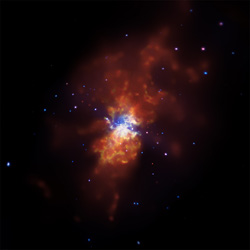Chandra Images Torrent of Star Formation

NASA/CXC/Wesleyan Univ./R.Kilgard et al.<br>M82 is a galaxy where stars are forming at rates that are tens or even hundreds of times higher than in a normal galaxy. In this Chandra image (where low, medium, and high-energy X-rays are colored red, green, and blue respectively), M82 is seen nearly edge-on with its disk crossing from about 10 o’clock to about 4 o’clock. There are over a hundred point-like X-ray sources, some of which are likely black holes pulling matter from companion stars. Supernovas have produced the large bubbles of hot gas that extend for millions of light years to the upper right and lower left of the galactic disk<br>
M82 is a so-called starburst galaxy, where stars are forming at rates that are tens or even hundreds of times higher than in a normal galaxy. The burst of star birth may be caused by a close encounter or collision with another galaxy, which sends shock waves rushing through the galaxy. In the case of M82, astronomers think that a brush with its neighboring galaxy M81 millions of years ago set off this torrent of star formation.
M82 is seen nearly edge-on with its disk crossing from about 10 o’clock to about 4 o’clock in this image from Chandra (where low, medium, and high-energy X-rays are colored red, green, and blue respectively.) Among the 104 point-like X-ray sources in the image, eight so far have been observed to be very bright in X-rays and undergo clear changes in brightness over periods of weeks and years. This means they are excellent candidates to be black holes pulling material from companion stars that are much more massive than the Sun. Only a handful of such binary systems are known in the Local Group of galaxies containing the Milky Way and M31.
Chandra observations are also important in understanding the consequences of the rapid rate at which supernovas explode in starburst galaxies. When the shock waves from supernovas rumble through the galaxy, they push on giant clouds of gas and dust, causing them to collapse and form massive stars. These stars, in turn, use up their fuel quickly and explode as supernovas. This chain reaction of supernovas produces expanding bubbles of multimillion-degree gas that extend for tens of thousands of light years above from the galaxy’s disk. The large red areas to the upper right and lower left of the image are examples of such bubbles.
NASA's Marshall Space Flight Center in Huntsville, Ala., manages the Chandra program for NASA's Science Mission Directorate in Washington. The Smithsonian Astrophysical Observatory controls Chandra's science and flight operations from Cambridge, Mass.
Media Contact
More Information:
http://www.cfa.harvard.eduAll latest news from the category: Physics and Astronomy
This area deals with the fundamental laws and building blocks of nature and how they interact, the properties and the behavior of matter, and research into space and time and their structures.
innovations-report provides in-depth reports and articles on subjects such as astrophysics, laser technologies, nuclear, quantum, particle and solid-state physics, nanotechnologies, planetary research and findings (Mars, Venus) and developments related to the Hubble Telescope.
Newest articles

Webb captures top of iconic horsehead nebula in unprecedented detail
NASA’s James Webb Space Telescope has captured the sharpest infrared images to date of a zoomed-in portion of one of the most distinctive objects in our skies, the Horsehead Nebula….

Cost-effective, high-capacity, and cyclable lithium-ion battery cathodes
Charge-recharge cycling of lithium-superrich iron oxide, a cost-effective and high-capacity cathode for new-generation lithium-ion batteries, can be greatly improved by doping with readily available mineral elements. The energy capacity and…

Novel genetic plant regeneration approach
…without the application of phytohormones. Researchers develop a novel plant regeneration approach by modulating the expression of genes that control plant cell differentiation. For ages now, plants have been the…





















